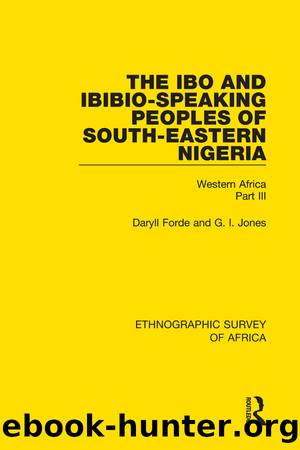The Ibo and Ibibio-Speaking Peoples of South-Eastern Nigeria by Daryll Forde G I Jones

Author:Daryll Forde, G I Jones [Daryll Forde, G I Jones]
Language: eng
Format: epub
ISBN: 9781315297705
Barnesnoble:
Goodreads: 34168077
Publisher: Routledge
Published: 2017-01-19T00:00:00+00:00
Arochuku T or VG 19 1,800 Aro
DISTINCTIVE FEATURES
The Aro are a tribe of specialist traders, many of whom are scattered throughout Ibo and Ibibio country, living either in particular local communities engaged in trade or in small farming settlements which they have bought and farm commercially to produce export crops. To-day they are found in three main concentrations: (1) the home tribe or settlement group of Arochuku with outlying plantations among the surrounding tribes; (2) Ndizorgu sub-tribe among the Northern Ibo (see Elugu, No. 28); (3) Ndienyi sub-tribe among the Northern Ibo (see Nri-Awka, No. 32). A large number of smaller settlements and isolated homesteads are now included for administrative purposes under various other tribes or groups.
The Aro claim to have emerged as a distinct group at the time when the Ada were migrating to the north. The village of Arochuku was founded after a successful revolt by Ibo slaves who called in the assistance of Akpa mercenaries (possibly an offshoot of Agwaâagune) against their Ibibio masters. Of the present patrilineages in Arochuku, six claim to be of Akpa, five of Ada Ibo, three of Amaseri Ibo, two of Ibibio and three of other origins.
At Arochuku was the shrine of a spirit called Chuku Ibinokpabiâthe Long Jujuâ famed as an oracle and also as a fertility spirit throughout the South-eastern Provinces. At the beginning of the present century the Aro spread through the NigerâCross River hinterland as traders, money-lenders and exploiters of the Long Juju. They dealt especially in slaves and gunpowder, and if a man could not pay his debts he sold one of his relatives or was himself sold. People who were unable to settle disputes wrere urged by the Aro, who had great prestige, to refer the issue to the shrine of the Long Juju, where, after suitable payments had been made, the priest settled the matter decisively by reporting the disappearance of one of the disputants. They often made a pretence of killing the victim, but actually sold him as a slave. Aro power and influence were also supported by hired mercenaries drawn from the Aba, Abam and Ada peoples.
The nineteen âtownsâ of the home tribe are derived from nine patrilineages (otusi) each under a headman (also otusi). These patrilineages are localized in the nine âparent townsâ, the remaining ten settlements being offshoots and accretions under an eze. The head of the Aro chiefly lineage is known as Eze-Aro and is the otusi of the âtownâ of Oror. He is the eldest living freeborn male tracing patrilineal descent from Oke-Nache> the traditional founder of his line, and is always regarded as the senior otusi no matter what his age. There are no data concerning the existence or character of matrilineal organization.
The Aro council consists of the nine otusi headmen, each representing one âtownâ, together with representatives from the other ten âtownsâ. The basis of its power is largely religious and it carries out an annual sacrifice of ekeji at the feast of new yams.
The Aro have
Download
This site does not store any files on its server. We only index and link to content provided by other sites. Please contact the content providers to delete copyright contents if any and email us, we'll remove relevant links or contents immediately.
| Historic | Information Systems |
| Regional |
Man-made Catastrophes and Risk Information Concealment by Dmitry Chernov & Didier Sornette(4728)
The Revenge of Geography: What the Map Tells Us About Coming Conflicts and the Battle Against Fate by Kaplan Robert D(3596)
Zero Waste Home by Bea Johnson(3285)
COSMOS by Carl Sagan(2944)
In a Sunburned Country by Bill Bryson(2940)
Good by S. Walden(2909)
The Fate of Rome: Climate, Disease, and the End of an Empire (The Princeton History of the Ancient World) by Kyle Harper(2428)
Camino Island by John Grisham(2379)
A Wilder Time by William E. Glassley(2358)
Organic Mushroom Farming and Mycoremediation by Tradd Cotter(2304)
Human Dynamics Research in Smart and Connected Communities by Shih-Lung Shaw & Daniel Sui(2173)
The Ogre by Doug Scott(2105)
Energy Myths and Realities by Vaclav Smil(2052)
The Traveler's Gift by Andy Andrews(2007)
Inside the Middle East by Avi Melamed(1937)
Birds of New Guinea by Pratt Thane K.; Beehler Bruce M.; Anderton John C(1903)
Ultimate Navigation Manual by Lyle Brotherton(1763)
A History of Warfare by John Keegan(1710)
And the Band Played On by Randy Shilts(1612)
